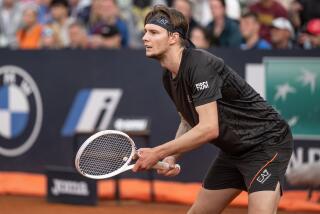Americans Turning Into Clay Pigeons
- Share via
PARIS — When officials in the trans-Atlantic world of men’s tennis evoke the image of Hands Across Water, imagine two clenched fists. The growing enmity here between European and American players is setting a new standard for griping.
The debate uses clay as a jumping-off point, and at the French Open--the foremost clay-court tournament in the world--old wounds are being opened. At issue is no less basic a question than turf: Why is it that men’s professional tennis is based in the United States and administered by Americans when the sport trails bowling in popularity in the States but is among the top two sports in much of Europe?
In part because only one of four Grand Slam events and three of the nine other high-profile tournaments are held in the United States, and the largest share of sponsorship money comes from European firms, most European players believe men’s professional tennis should be run from their side of the Atlantic.
Many don’t like the Americans’ perceived lack of respect for tradition and the U.S. corporate involvement that they contend gives preferential treatment to U.S. players.
The anti-American parade is being led by Thomas Muster of Austria, ranked No. 2 in the world. His sensitivity was raised after he was widely criticized by American players when, through the strength of playing mainly on clay in Europe, Muster reached No. 1 two months ago.
“Let them play by themselves,” Muster said of American players. “Let’s not invite them here. Let’s stop giving them our money. Why do they come here? Because they make more money here. Everything is controlled by the Americans, so what should we do? If the players don’t close ranks, we’ll be eaten up.”
Some fans, apparently, are beginning to agree. Andre Agassi’s second-round loss Wednesday generated an amazing, sometimes vicious, backlash. Fans, players and coaches adopted a good-riddance attitude toward the flamboyant Agassi, who is often held up as an example of American coarseness.
David Miller, writing in Thursday’s editions of the Times of London, represented the general sentiments about both Agassi and Nike, his apparel company. Miller referred to Nike as a “vulgar, opportunistic equipment sponsor, who send him on the court dressed like some Baghdad street trader. This greed--by the same company that has kitted out Mary Pierce in a black cocktail dress and [Pete] Sampras in the Coco the Clown’s trousers--is a corruption of the game’s elegance.”
Nike’s rise as a force in tennis is viewed by some as sinister. Boris Becker suggested that the court assignments at Wimbledon last year were influenced by Nike, in favor of Agassi. He said the same thing a few months later at the U.S. Open. When “commercial interests” are criticized for holding sway in tennis, usually it’s a reference to the Oregon-based company.
To some, it’s a question of style. Americans, critics say, don’t respect the traditions of the game. Playing on clay is one of those traditions held dear by Europeans and largely ignored by Americans. Muster, it was noted by American players, played 70% of his matches on clay last season. But Europeans point out that Agassi played 71% of his matches on hard courts.
Americans’ shortcomings on clay are never more highlighted than at the French Open. Many on the tour are offended that American players aren’t as upset by losing here as they are at the other Grand Slam events.
European players here are nearly united in their wish that the tour’s headquarters be moved from Florida to Europe, but they offer no suggestions as to which country it should be placed nor any idea what sensibility a European-run tour might carry.
“I agree with Thomas that it should not be an American company that is running the ATP and running [it] the American way,” said Michael Stich of Germany. “I think there should be something in the middle, something more for the Europeans.”
To Muster, it would mean more clay-court tournaments and a longer season. As the schedule exists, the clay-court season runs from the middle of April to the first week in June. If a clay-court specialist is injured during that time, his season is lost.
The season is stacked toward hard-court tournaments and sites in the United States. The Super 9 are the most important events on the tour outside the Grand Slam tournaments, events in which players earn more points and more money for winning. Only three Super 9 events are on clay. Five of the events are in Europe and three in the United States, one in Canada. The men’s Assn. of Tennis Professionals and Women’s Tennis Assn. tours are based in the United States, as are the three major management companies and influential apparel and sporting goods manufacturers.
Yet there are only seven Americans in the men’s top 50 and 12 in the top 100. The question is why should Americans have so much power in a sport driven by European interests. For example, Eurosport, the all-sport cable network, last year signed a four-year, $80-million contract to televise ATP Tour events. That’s far more money than American networks would be willing to invest in tennis.
Said Stich: “I come from a country where most of the money for tennis is generated these days. For that part, I think Thomas is right. Then again, I think you have to put a little bit in perspective with tennis in the different countries.
“In Germany, tennis is the No. 2 sport, behind soccer. A lot of other countries, it’s the same. In America, it’s like the No. 9 or No. 10 sport. They have so many sports there that are much more popular than tennis. Still, I think the Americans are very important.”
That makes one hand, tentatively stretched across the water.
More to Read
Go beyond the scoreboard
Get the latest on L.A.'s teams in the daily Sports Report newsletter.
You may occasionally receive promotional content from the Los Angeles Times.











